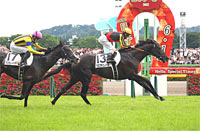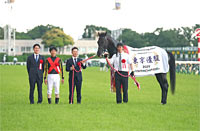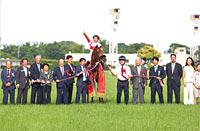2016 News
Data Analysis for the Tokyo Yushun (Japanese Derby)Race to decide strongest of the generation – particularly meaningful to horsemen and fans alike Over the last 30 years, the Japanese Derby has been won by the favorite 16 times. In performance statistics, the favorites have amassed an aggregate record of [16-5-2-7] in that time, producing a Top 2 ratio of 70.0% and a Top 3 ratio of 76.7%. In fact, of all the JRA G1, Jpn1 and Jump G1 races held multiple times over the 30 years between 1986 and 2015, the Japanese Derby is the only race in which the favorite has achieved a Win ratio of more than 50%. One reason why it is relatively easy for pre-race expectations to match the race outcome could be that the Japanese Derby attracts a high level of attention, even compared to the many other big races, and more energy is thus invested in forecasting the outcome. So will the horse recognized as the leading candidate by racing fans all over Japan again live up to expectations this year? Or will a dark horse surprise us all by reaching the pinnacle of its generation? This time, let’s analyze points shared by strong performers in this race from results over the last 10 years. Look for wins in graded races Of 30 Top 3 finishers over the last 10 years, 25 already had experience of winning turf graded races over distances of 1,800m or more at the four major JRA racecourses (Tokyo, Nakayama, Kyoto, Hanshin). Horses in this category have also notched superior success ratios, with a Top 3 ratio of 32.5%. This year, too, our attention should first be on runners with a track record of wins in medium- to long-distance graded races. [Table 1] [Table 1] Performance by experience of winning 1,800m+ turf graded races at the four major JRA racecourses (Tokyo, Nakayama, Kyoto, Hanshin) (last 10 years)
Moreover, of the five Top 3 finishers without prior experience of winning turf graded races over distances of 1,800m or more at the four major JRA racecourses (Tokyo, Nakayama, Kyoto, Hanshin), all except 2007 winner Vodka had weighed “510kg or more” in their most recent outing. When comparing runners without wins in medium- to long-distance graded races, we should perhaps focus on their weight last time out. [Table 2] [Table 2] Performance of horses without experience of winning 1,800m+ graded races at the four major JRA racecourses (Tokyo, Nakayama, Kyoto, Hanshin) by weight in the previous race (last 10 years)
Favoritism in the previous race also important Of 30 Top 3 finishers over the last 10 years, 24 had been backed “among the Top 4 favorites” in their most recent outing. By contrast, those supported only as “5th favorite or lower” have struggled, with a Top 3 ratio of only 7.3%. As well as the content and result of the previous race, the level of favoritism to win that race could also be seen as an important point. [Table 3] [Table 3] Performance by favoritism to win the previous race (last 10 years)
Meanwhile, viewing aggregate performances by favoritism to win the previous race when it was the Satsuki Sho (Japanese 2000 Guineas), the gap in success ratios between those backed “among the Top 4 favorites” and those supported only as “5th favorite or lower” is even greater. When comparing highly favorable runners coming straight from the Satsuki Sho, our focus should be on this trend in particular. [Table 4] [Table 4] Performance by favoritism to win the Satsuki Sho when it was the previous race (last 10 years)
Dominance of horses starting from the innermost bracket Viewing aggregate performances by horse number over the last 10 years, runners with horse numbers “1-3” have produced excellent results, including a Top 3 ratio of 40.0%. Last year, for example, Satono Rasen was Horse 1 in Bracket 1, and finished as runner-up with win odds of 18.7-1. We should keep a watch on runners given the inner gate (horse) numbers. [Table 5] [Table 5] Performance by horse number (last 10 years)
Discount horses with a “change of rider” The Japanese Derby is known to be rarely won by horses with a “change of rider” from their previous races. In fact, no horse ridden by a different jockey compared to its previous outing has won this race since Sirius Symboli in 1985. What’s more, focusing only on the seven years since 2009, horses with a change of rider have only managed a Top 3 ratio of 8.9% in that time. Until 2008, horses ridden by different jockeys did occasionally make it into 2nd or 3rd place, but we should take note of the fact that even those cases are on the decline. [Table 6] [Table 6] Performance by jockey (last 7 years)
Strong performers in trial races dominant in recent years All 18 Top 3 finishers since 2010 had most recently contested in the “Satsuki Sho,” “Kyoto Shimbun Hai” or “TV Tokyo Hai Aoba Sho.” We may need to lower our expectations of horses coming from other races, such as the NHK Mile Cup. [Table 7] [Table 7] Performance by previous race (last 6 years)
More specifically, no horse most recently seen in the Satsuki Sho has finished in the Top 2 here when finishing “5th or lower” in the Satsuki Sho. [Table 8] [Table 8] Performance by finish in the “Satsuki Sho” when it was the last race (last 6 years)
Again, of horses most recently appearing in the TV Tokyo Hai Aoba Sho and Kyoto Shimbun Hai, none has finished in the Top 2 here if the finish in that race was “2nd or lower.” Judging from recent trends, our attention should be on higher-placed finishers in the Satsuki Sho or winners of the TV Tokyo Hai Aoba Sho and Kyoto Shimbun Hai. [Table 9] [Table 9] Performance by finish in the “TV Tokyo Hai Aoba Sho” or “Kyoto Shimbun Hai” when it was the last race (last 6 years)
Seek out the winner! All of the last six winners had most recently contested in the “Satsuki Sho” or the “Kyoto Shimbun Hai” and had finished “4th or higher” in that race. As can be judged from Tables 7 to 9, we should be focusing on horses with strong performances in the Satsuki Sho and major trial races. Other points shared by these six are that they all had previous experience of winning turf graded races over distances of 1,800m or more at the four major JRA racecourses (Tokyo, Nakayama, Kyoto, Hanshin), and that they were all ridden by the same jockey as last time out. The points raised in Tables 1 and 6 must also be worthy of attention. [Table 10] [Table 10] The “Previous race,” “Finish in previous race,” “Highest finish in turf graded races over 1,800m+ at the four major JRA racecourses,” “Jockey last time” and “Jockey this time” of winning horses (last 6 years)
(Masaya Ibuki) |

|



















